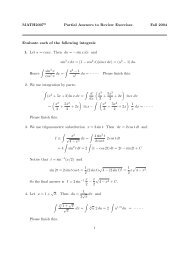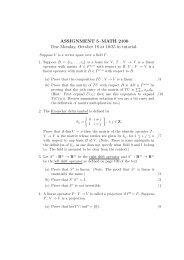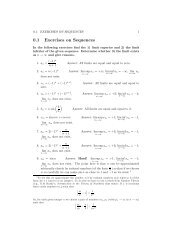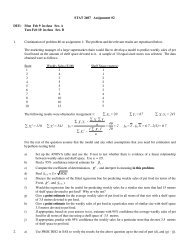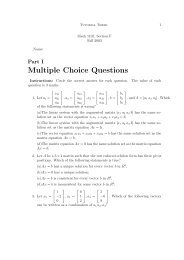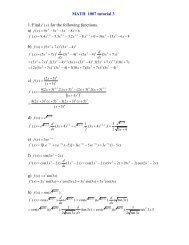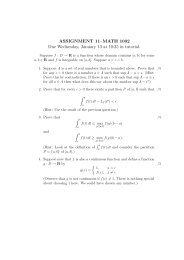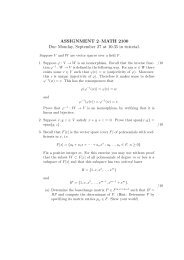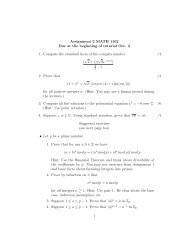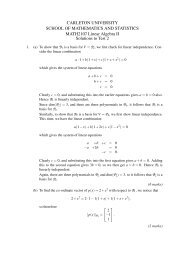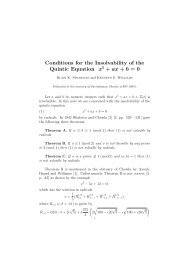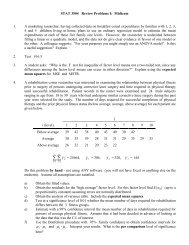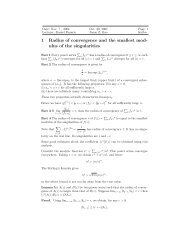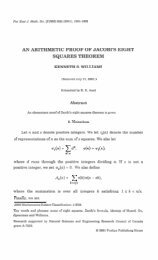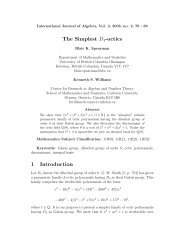On generalized Lucas sequences - Mathematics and Statistics ...
On generalized Lucas sequences - Mathematics and Statistics ...
On generalized Lucas sequences - Mathematics and Statistics ...
Create successful ePaper yourself
Turn your PDF publications into a flip-book with our unique Google optimized e-Paper software.
Contemporary <strong>Mathematics</strong><br />
<strong>On</strong> <strong>generalized</strong> <strong>Lucas</strong> <strong>sequences</strong><br />
Qiang Wang<br />
This paper is dedicated to Professor G. B. Khosrovshahi on the occasion of his 70th birthday<br />
<strong>and</strong> to IPM on its 20th birthday.<br />
Abstract. We introduce the notions of unsigned <strong>and</strong> signed <strong>generalized</strong> <strong>Lucas</strong><br />
<strong>sequences</strong> <strong>and</strong> prove certain polynomial recurrence relations on their characteristic<br />
polynomials. We also characterize when these characteristic polynomials<br />
are irreducible polynomials over a finite field. Moreover, we obtain the explicit<br />
expressions of the remainders of Dickson polynomials of the first kind<br />
divided by the characteristic polynomial of <strong>generalized</strong> <strong>Lucas</strong> <strong>sequences</strong>. Using<br />
these remainders, we show an application of <strong>generalized</strong> <strong>Lucas</strong> <strong>sequences</strong> in the<br />
characterization of a class of permutation polynomials <strong>and</strong> their compositional<br />
inverses.<br />
1. Introduction<br />
Fibonacci numbers form an integer sequence<br />
0, 1, 1, 2, 3, 5, 8, 13, 21, 34, 55, . . .<br />
which was well known in ancient India. To the western world, it became popular<br />
through the Italian Mathematician, Leonardo of Pisa known as Fibonacci (1170-<br />
1250), who considered the growth of an idealized (biologically unrealistic) rabbit<br />
population by using this sequence in his famous book Liber Abaci (1202). In the<br />
language of recurrence relation, Fibonacci numbers {Fn} ∞ n=0 satisfy a second order<br />
homogeneous recurrence relation given by<br />
F0 = 0, F1 = 1, Fn = Fn−1 + Fn−2 for n ≥ 2.<br />
The so-called <strong>Lucas</strong> numbers {Ln} ∞ n=0 have the same recurrence relation but different<br />
initial values, that is,<br />
L0 = 2, L1 = 1, Ln = Ln−1 + Ln−2 for n ≥ 2.<br />
1991 <strong>Mathematics</strong> Subject Classification. Primary 11B39; Secondary 11T06.<br />
Key words <strong>and</strong> phrases. <strong>Lucas</strong> <strong>sequences</strong>, finite fields, Dickson polynomials, irreducible polynomials,<br />
permutation polynomials.<br />
Research of the author was partially supported by NSERC of Canada. The author wants<br />
to thank Hadi Kharaghani for kind <strong>and</strong> continuous support, <strong>and</strong> generous hospitality during the<br />
visit to IPM. The author also wants to thank IPM, Behruz Tayfeh-Rezaie, <strong>and</strong> Saieed Akbari for<br />
their warm hospitality. Finally the author thanks the referee for helpful suggestions.<br />
1<br />
c○0000 (copyright holder)
2 QIANG WANG<br />
Nowadays, <strong>Lucas</strong> <strong>sequences</strong> are referred as a family of <strong>sequences</strong> with the similar<br />
structure. For a given pair of integers P, Q such that △ = P 2 − 4Q is a nonsquare,<br />
there are two types of <strong>Lucas</strong> <strong>sequences</strong>. The first type is usually denoted<br />
by {Vn(P, Q)} ∞ n=0 where<br />
V0(P, Q) = 2, V1(P, Q) = P, Vn(P, Q) = P Vn−1(P, Q) − QVn−2(P, Q) for n ≥ 2.<br />
The second type of <strong>sequences</strong> {Un(P, Q)} ∞ n=0 is defined via<br />
U0(P, Q) = 0, U1(P, Q) = 1, Un(P, Q) = P Un−1(P, Q) − QUn−2(P, Q) for n ≥ 2.<br />
We call {Vn(P, Q)} ∞ n=0 the first type because we will see that they can be obtained<br />
from Dickson polynomials of the first kind. Similarly, the sequence {Un(P, Q)} ∞ n=0<br />
can be obtained from Dickson polynomials of the second kind. Hence Fibonacci<br />
numbers <strong>and</strong> <strong>Lucas</strong> numbers are {Un(1, −1)} ∞ n=0 <strong>and</strong> {Vn(1, −1)} ∞ n=0 respectively.<br />
When P = 2 <strong>and</strong> Q = −1, <strong>sequences</strong> {Un(2, −1)} ∞ n=0 <strong>and</strong> {Vn(2, −1)} ∞ n=0 are called<br />
Pell numbers <strong>and</strong> Pell-<strong>Lucas</strong> numbers respectively.<br />
It is well-known that Ln = Vn(1, −1) = an + bn where a = 1+√5 2 <strong>and</strong> b = 1−√5 2 .<br />
Let η be a primitive 10-th root of unity, then we can rewrite a = η + η−1 , b =<br />
η3 + η−3 , <strong>and</strong> thus Ln = (η + η−1 ) n + (η3 + η−3 ) n . Hence this motivated us to<br />
introduce the following <strong>generalized</strong> notion of <strong>Lucas</strong> numbers in our previous work.<br />
Definition 1.1. ([4]) For any integer k ≥ 1 <strong>and</strong> η a fixed primitive (4k + 2)th<br />
root of unity, the <strong>generalized</strong> <strong>Lucas</strong> sequence (or unsigned <strong>generalized</strong> <strong>Lucas</strong><br />
sequence) of order k is defined as {an} ∞ n=0 such that<br />
an =<br />
2k<br />
(η t + η −t ) n =<br />
t=1<br />
t odd<br />
k<br />
t=1<br />
((−1) t+1 (η t + η −t )) n .<br />
We note that the <strong>Lucas</strong> numbers are simply <strong>generalized</strong> <strong>Lucas</strong> <strong>sequences</strong> of<br />
order k = 2. Similarly, we can define<br />
Definition 1.2. For any integer k ≥ 1 <strong>and</strong> η a fixed primitive (4k + 2)-th root<br />
of unity, the signed (or alternating) <strong>generalized</strong> <strong>Lucas</strong> sequence of order k is defined<br />
as {bn} ∞ n=0 such that<br />
bn =<br />
2k<br />
t=1<br />
t even<br />
(η t + η −t ) n =<br />
k<br />
t=1<br />
((−1) t (η t + η −t )) n .<br />
In fact, we will see that all the coefficients of both characteristic polynomials of<br />
signed <strong>and</strong> unsigned <strong>generalized</strong> <strong>Lucas</strong> <strong>sequences</strong> of order k are integers <strong>and</strong> then<br />
using Waring’s formula we can conclude that both <strong>sequences</strong> are integer <strong>sequences</strong>.<br />
Several examples of these families of integer <strong>sequences</strong> can be found in Sloan’s <strong>On</strong>-<br />
Line Encyclopedia of Integer Sequences. For example, <strong>generalized</strong> <strong>Lucas</strong> sequence<br />
of order 4 is called an accelerator sequence for Catalan’s constant (A094649). Similarly,<br />
the signed <strong>generalized</strong> <strong>sequences</strong> of order 3 <strong>and</strong> 5 are numbered as A094648<br />
<strong>and</strong> A094650 respectively.<br />
The following tables (Table 1, Table 2) contain initial values <strong>and</strong> recurrence<br />
relations of unsigned <strong>and</strong> signed <strong>generalized</strong> <strong>Lucas</strong> sequence of order k for small<br />
k’s.
ON GENERALIZED LUCAS SEQUENCES 3<br />
Table 1. Generalized <strong>Lucas</strong> <strong>sequences</strong><br />
k initial values recurrence relations<br />
k = 1 1 an+1 = an<br />
k = 2 2, 1 an+2 = an+1 + an<br />
k = 3 3, 1, 5 an+3 = an+2 + 2an+1 − an<br />
k = 4 4, 1, 7, 4 an+4 = an+3 + 3an+2 − 2an+1 − an<br />
k = 5 5, 1, 9, 4, 25 an+5 = an+4 + 4an+3 − 3an+2 − 3an+1 + an<br />
Table 2. Signed <strong>generalized</strong> <strong>Lucas</strong> <strong>sequences</strong><br />
k initial values recurrence relations<br />
k = 1 1 bn+1 = −bn<br />
k = 2 2, −1 bn+2 = −bn+1 + bn<br />
k = 3 3, −1, 5 bn+3 = −bn+2 + 2bn+1 + bn<br />
k = 4 4, −1, 7, −4 bn+4 = −bn+3 + 3bn+2 + 2bn+1 − bn<br />
k = 5 5, −1, 9, −4, 25 bn+5 = bn+4 + 4bn+3 + 3bn+2 − 3bn+1 − bn<br />
It is easy to see from the definition that the characteristic polynomial of <strong>generalized</strong><br />
<strong>Lucas</strong> sequence of order k ≥ 1 is<br />
gk(x) =<br />
2k<br />
(x − (η t + η −t )).<br />
t=1<br />
t odd<br />
Similarly, the characteristic polynomial of signed <strong>generalized</strong> <strong>Lucas</strong> sequence of<br />
order k ≥ 1 is<br />
fk(x) =<br />
2k<br />
(x − (η t + η −t )).<br />
t=1<br />
t even<br />
It is easy to see that f1(x) = x + 1, f2(x) = x2 + x − 1, g1(x) = x − 1, <strong>and</strong><br />
g2(x) = x2 − x − 1. By convention, we let f0(x) = g0(x) = 1.<br />
In Section 2, we show that both characteristic polynomials of degree k satisfy<br />
interesting recurrence relations with characteristic polynomials of degree k − 1 <strong>and</strong><br />
k − 2 (Theorem 2.1, Theorem 2.2). Namely,<br />
(1.1) f0(x) = 1, f1(x) = x + 1, fk(x) = xfk−1(x) − fk−2(x) for k ≥ 2<br />
<strong>and</strong><br />
(1.2) g0(x) = 1, g1(x) = x − 1, gk(x) = xgk−1(x) − gk−2(x) for k ≥ 2.<br />
These polynomial recurrence relations provide us an easy way to compute characteristic<br />
polynomials of the <strong>generalized</strong> <strong>Lucas</strong> <strong>sequences</strong> <strong>and</strong> signed <strong>generalized</strong> <strong>Lucas</strong><br />
<strong>sequences</strong> even for large k. Hence it is quite fast to generate unsigned <strong>and</strong> signed<br />
<strong>generalized</strong> <strong>Lucas</strong> <strong>sequences</strong>. Moreover, we characterize when degree k polynomials
4 QIANG WANG<br />
fk(x) <strong>and</strong> gk(x) are irreducible polynomials over a finite field Fq. It turns out that<br />
2k + 1 must be prime (Theorem 2.5). In Section 3, we use some divisibility properties<br />
of characteristic polynomials gk(x) to obtain the explicit expressions for the<br />
remainders Rn,k(x) of Dickson polynomials Dn(x) of the first kind divided by gk(x)<br />
(Theorem 3.2). As an application, we explain the connection between <strong>generalized</strong><br />
<strong>Lucas</strong> <strong>sequences</strong> over a prime field, Rn,k(x), <strong>and</strong> a class of permutation polynomials<br />
<strong>and</strong> their inverses over an extension field (Theorem 3.3 <strong>and</strong> Theorem 3.8,<br />
respectively).<br />
2. Characteristic polynomials<br />
For any integer n ≥ 1 <strong>and</strong> a parameter a in a field F, we recall that the Dickson<br />
polynomial of the first kind Dn(x, a) ∈ F[x] of degree n is defined by<br />
Dn(x, a) =<br />
⌊n/2⌋ <br />
i=0<br />
n<br />
n − i<br />
n − i<br />
i<br />
<br />
(−a) i x n−2i .<br />
Similarly, the Dickson polynomial of the second kind En(x, a) ∈ F[x] of degree n is<br />
defined by<br />
⌊n/2⌋ <br />
<br />
n − i<br />
En(x, a) =<br />
(−a)<br />
i<br />
i x n−2i .<br />
i=0<br />
For a = 0, we write x = y+a/y with y = 0 an indeterminate. Then the Dickson<br />
polynomials can often be rewritten (also referred as functional expression) as<br />
<br />
Dn(x, a) = Dn y + a<br />
<br />
, a = y<br />
y n + an<br />
,<br />
yn <strong>and</strong><br />
En(x, a) = En<br />
<br />
y + a<br />
<br />
, a<br />
y<br />
= yn+1 − an+1 /yn+1 ,<br />
y − a/y<br />
for y = ± √ a; For y = ± √ a, we have En(2 √ a, a) = (n+1)( √ a) n <strong>and</strong> En(−2 √ a, a) =<br />
(n + 1)(− √ a) n . It is well known that Dn(x, a) = xDn−1(x, a) − aDn−2(x, a) <strong>and</strong><br />
En(x, a) = xEn−1(x, a) − aEn−2(x, a) for any n ≥ 2. Here we also note that<br />
Vn(P, Q) = Dn(P, Q) <strong>and</strong> Un+1(P, Q) = En(P, Q).<br />
In the case a = 1, we denote Dickson polynomials of degree n of the first <strong>and</strong> the<br />
second kind by Dn(x) <strong>and</strong> En(x) respectively. It is well known that these Dickson<br />
polynomials are closely related to the Chebyshev polynomials by the connections<br />
Dn(2x) = 2Tn(x) <strong>and</strong> En(2x) = Un(x), where Tn(x) <strong>and</strong> Un(x) are Chebyshev<br />
polynomials of degree n of the first <strong>and</strong> the second kind, respectively. More information<br />
on Dickson polynomials can be found in [11].<br />
For any k ≥ 1, let η be a primitive (4k + 2)-th root of unity. It is well known<br />
that η t + η −t with 1 ≤ t ≤ 2k are all the roots of E2k(x). Hence the characteristic<br />
polynomials fk(x) <strong>and</strong> gk(x) of signed <strong>and</strong> unsigned <strong>generalized</strong> <strong>Lucas</strong> <strong>sequences</strong> are<br />
both factors of E2k(x). In fact, E2k(x) = fk(x)gk(x) because all three polynomials<br />
are monic.<br />
Next we prove the following results on the polynomial recurrence relations on<br />
the characteristic polynomials fk(x) <strong>and</strong> gk(x).
Theorem 2.1. Let gk(x) =<br />
ON GENERALIZED LUCAS SEQUENCES 5<br />
2k<br />
(x − (η t + η −t )) be the characteristic polyno-<br />
t=1<br />
t odd<br />
mial of <strong>generalized</strong> <strong>Lucas</strong> sequence of order k ≥ 1 <strong>and</strong> g0(x) = 1. Then<br />
(i) gk(x) = Ek(x) − Ek−1(x) for k ≥ 1.<br />
(ii) gk(x) satisfies the following recurrence relation:<br />
g0(x) = 1, g1(x) = x − 1, gk(x) = xgk−1(x) − gk−2(x) for k ≥ 2.<br />
(iii) The generating function of the above recurrence is G(x; t) = 1−t<br />
1−xt+t2 .<br />
k<br />
i ⌈<br />
(iv) gk(x) = (−1) 2 ⌉<br />
i k − ⌈ 2⌉ <br />
x k−i .<br />
i=0<br />
⌊ i<br />
2 ⌋<br />
Proof. Let Gk(x) = Ek(x) − Ek−1(x) for k ≥ 1. Using the functional expres-<br />
sion Ek(y + y−1 ) = yk+1−y −(k+1)<br />
y−y−1 , we can easily obtain Gk(y + y−1 ) = y(2k+1) +1<br />
yk (y+1) .<br />
In particular, let η be a primitive (4k + 2)-th root of unity. Hence η2k+1 = −1<br />
<strong>and</strong> thus Gk(η t + η −t ) = η(2k+1)t +1<br />
η tk (η t +1)<br />
= 0 for all odd t. Hence all the roots of gk(x)<br />
are roots of Gk(x). Moreover, deg(Gk(x)) = deg(gk(x)) = k <strong>and</strong> both Gk(x) <strong>and</strong><br />
gk(x) are monic, we conclude that (i) is satisfied. Using the recurrence relation<br />
Ek(x) = xEk−1(x) − Ek−2(x), one obtains (ii) immediately. Moreover, the generating<br />
function G(x; t) of gk(x) can be derived from<br />
(1 − xt + t 2 )G(x; t) = (1 − xt + t 2 )<br />
=<br />
k=0<br />
∞<br />
gk(x)t k<br />
k=0<br />
∞<br />
gk(x)t k ∞<br />
− xgk(x)t k+1 ∞<br />
+ gk(x)t k+2<br />
k=0<br />
= 1 + (x − 1)t − xt +<br />
= 1 − t.<br />
Finally, to prove (iv), we have<br />
j=0<br />
k=0<br />
∞<br />
(gk+2(x) − xgk+1(x) + gk(x))t k+2<br />
gk(x) = Ek(x) − Ek−1(x)<br />
=<br />
⌊k/2⌋ <br />
(−1) j<br />
<br />
k − j<br />
x<br />
j<br />
k−2j ⌊(k−1)/2⌋ <br />
− (−1) j<br />
<br />
k − 1 − j<br />
x<br />
j<br />
k−1−2j<br />
=<br />
=<br />
i=0<br />
i even<br />
k=0<br />
j=0<br />
k<br />
(−1) ⌈i/2⌉<br />
<br />
n − ⌈i/2⌉<br />
x<br />
⌊i/2⌋<br />
k−i −<br />
k<br />
(−1) ⌈i/2⌉<br />
<br />
k − ⌈i/2⌉<br />
x<br />
⌊i/2⌋<br />
k−i .<br />
i=0<br />
k<br />
(−1) ⌊i/2⌋<br />
<br />
k − ⌈i/2⌉<br />
x<br />
⌊i/2⌋<br />
k−i<br />
i=0<br />
i odd<br />
Similarly, we have the following result for signed <strong>generalized</strong> <strong>Lucas</strong> <strong>sequences</strong>.
6 QIANG WANG<br />
Theorem 2.2. Let fk(x) =<br />
2k<br />
t=1<br />
t even<br />
(x − (η t + η −t )) be the characteristic polyno-<br />
mial of signed <strong>generalized</strong> <strong>Lucas</strong> sequence of order k ≥ 1 <strong>and</strong> f0(x) = 1. Then<br />
(i) fk(x) = Ek(x) + Ek−1(x) for k ≥ 1.<br />
(ii) fk(x) satisfies the following recurrence relation:<br />
f0(x) = 1, f1(x) = x + 1, fk(x) = xfk−1(x) − fk−2(x) for k ≥ 2.<br />
(iii) The generating function of the above recurrence is F (x; t) = 1+t<br />
1−xt+t2 .<br />
k<br />
i ⌊<br />
(iv) fk(x) = (−1) 2 ⌋<br />
i k − ⌈ 2⌉ <br />
x k−i .<br />
i=0<br />
⌊ i<br />
2 ⌋<br />
Proof. Let Fk(x) = Ek(x) + Ek−1(x) for k ≥ 1. Using the functional expression<br />
of En(x), we can easily obtain Fk(y + y−1 ) = y(2k+1) −1<br />
yk . In particu-<br />
(y−1)<br />
lar, let η be a primitive (4k + 2)-th root of unity. Hence η2k+1 = −1 <strong>and</strong> thus<br />
Fk(η t + η −t ) = η(2k+1)t −1<br />
η tk (η t −1) = 0 for all even t. Hence all the roots of fk(x) are<br />
roots of Fk(x). Moreover, deg(Fk(x)) = deg(fk(x)) = k <strong>and</strong> both Fk(x) <strong>and</strong> fk(x)<br />
are monic. Hence we conclude that (i) is satisfied. Using the recurrence relation<br />
Ek(x) = xEk−1(x) − Ek−2(x), one obtains (ii) immediately. Moreover, the gener-<br />
ating function F (x; t) of fk(x) can be derived from<br />
(1 − xt + t 2 )F (x; t) = (1 − xt + t 2 ∞<br />
) fk(x)t k<br />
=<br />
k=0<br />
k=0<br />
∞<br />
fk(x)t k ∞<br />
− xfk(x)t k+1 ∞<br />
+ fk(x)t k+2<br />
k=0<br />
= 1 + (x + 1)t − xt +<br />
= 1 + t.<br />
Finally, to prove (iv), we have<br />
j=0<br />
k=0<br />
∞<br />
(fk+2(x) − xfk+1(x) + fk(x))t k+2<br />
fk(x) = Ek(x) + Ek−1(x)<br />
=<br />
⌊k/2⌋ <br />
(−1) j<br />
<br />
k − j<br />
x<br />
j<br />
k−2j ⌊(k−1)/2⌋ <br />
+ (−1) j<br />
<br />
k − 1 − j<br />
x<br />
j<br />
k−1−2j<br />
=<br />
=<br />
i=0<br />
i even<br />
k=0<br />
j=0<br />
k<br />
(−1) ⌊i/2⌋<br />
<br />
k − ⌈i/2⌉<br />
x<br />
⌊i/2⌋<br />
k−i +<br />
k<br />
(−1) ⌊i/2⌋<br />
<br />
k − ⌈i/2⌉<br />
x<br />
⌊i/2⌋<br />
k−i .<br />
i=0<br />
k<br />
(−1) ⌊i/2⌋<br />
<br />
k − ⌈i/2⌉<br />
x<br />
⌊i/2⌋<br />
k−i<br />
i=0<br />
i odd<br />
The functional expressions of fk(x) <strong>and</strong> gk(x) are quite useful in the above<br />
proofs. We summarize them as follows:<br />
(2.1) fk(y+y −1 ) = y2k+1 − 1<br />
y k (y − 1) for y = 0, ±1, fk(2) = 2k+1, <strong>and</strong> fk(−2) = (−1) k ;
<strong>and</strong><br />
(2.2)<br />
ON GENERALIZED LUCAS SEQUENCES 7<br />
gk(y + y −1 ) = y2k+1 + 1<br />
y k (y + 1) for y = 0, ±1, gk(2) = 1, <strong>and</strong> gk(−2) = (−1) k (2k + 1).<br />
Using these functional expressions, one can also easily obtain the following result<br />
(see also Exercise 2.11 in [11]).<br />
Corollary 2.3. Let fk(x) <strong>and</strong> gk(x) be characteristic polynomials of signed<br />
<strong>and</strong> unsigned <strong>generalized</strong> <strong>Lucas</strong> <strong>sequences</strong> of order k. Then we have<br />
(i) fm+n(x) = fm(x)En(x) − fm−1(x)En−1(x).<br />
(ii) gm+n(x) = gm(x)En(x) − gm−1(x)En−1(x).<br />
(iii) If (2d + 1) | (2k + 1) then fd(x) | fk(x) <strong>and</strong> gd(x) | gk(x).<br />
Next we will see some applications of E2k(x) = fk(x)gk(x). First, using<br />
E2k(x) = fk(x)gk(x), Theorem 2.1 <strong>and</strong> Theorem 2.2, it is obvious to obtain the<br />
following interesting combinatorial identity for any 0 ≤ m ≤ 2k.<br />
k<br />
i,j=0<br />
i+j=m<br />
i ⌈<br />
(−1) 2 ⌉<br />
i k − ⌈ 2⌉ <br />
(−1)<br />
⌊ i<br />
2 ⌋<br />
j<br />
⌊ 2 ⌋<br />
j<br />
k − ⌈ 2⌉ <br />
0 if m is odd;<br />
=<br />
if m is even.<br />
⌊ j<br />
2 ⌋<br />
(−1) m<br />
2<br />
m 2k− <br />
2<br />
m<br />
2<br />
Now we can characterize when fk(x) <strong>and</strong> gk(x) are irreducible polynomials over<br />
a finite field. Let Fq be a finite field with char(Fq) = p. Since the factorization of<br />
E2k(x) over a finite field Fq is well known (see for example, [6] or [8]), we can obtain<br />
the factorization of fk(x) <strong>and</strong> gk(x) over Fq as well. Of course, it is enough to give<br />
the result for the case that gcd(2k +1, p) = 1. Indeed, if (2k +1) = pr (2t+1) where<br />
gcd(2t + 1, p) = 1, then it is straightforward to obtain fk(x) = ft(x) pr(x<br />
− 2) pr −1<br />
2<br />
<strong>and</strong> gk(x) = gt(x) pr<br />
gk(x).<br />
(x + 2) pr −1<br />
2 by using the functional expressions of fk(x) <strong>and</strong><br />
Theorem 2.4. Let Fq be a finite field with char(Fq) = p, gcd(2k + 1, p) = 1,<br />
<strong>and</strong> φ be Euler’s totient function.<br />
(i) If q is even, then fk(x) = gk(x) is a product of irreducible polynomials in<br />
Fq[x] which occur in cliques corresponding to the divisors d of 2k + 1 with d > 1.<br />
To each such d there correspond φ(d)/2kd irreducible factors, each of which has the<br />
form<br />
<br />
kd−1<br />
i=0<br />
(x − (ζ qi<br />
d<br />
+ ζ−qi<br />
d )).<br />
where ζd is a primitive d-th root of unity <strong>and</strong> kd is the least positive integer such<br />
that q kd ≡ ±1 (mod d).<br />
(ii) If q is odd, then fk(x) is a product of irreducible polynomials in Fq[x] which<br />
occur in cliques corresponding to the odd divisors d of 4k + 2 with d > 2. To each<br />
such d there correspond φ(d)/2kd irreducible factors, each of which has the form<br />
<br />
kd−1<br />
i=0<br />
(x − (ζ qi<br />
d<br />
+ ζ−qi<br />
d )).<br />
where ζd is a primitive d-th root of unity <strong>and</strong> kd is the least positive integer such<br />
that q kd ≡ ±1 (mod d).
8 QIANG WANG<br />
(iii) If q is odd, then gk(x) is a product of irreducible polynomials in Fq[x] which<br />
occur in cliques corresponding to the even divisors d of 4k + 2 with d > 2. To each<br />
such d there correspond φ(d)/2kd irreducible factors, each of which has the form<br />
<br />
kd−1<br />
i=0<br />
(x − (ζ qi<br />
d<br />
+ ζ−qi<br />
d )).<br />
where ζd is a primitive d-th root of unity <strong>and</strong> kd is the least positive integer such<br />
that q kd ≡ ±1 (mod d).<br />
Proof. It is easy to see that fk(x) = gk(x) for even q. Moreover, if q is odd<br />
<strong>and</strong> d is odd, then ζd is a even power of a primitive (4k + 2)-th root of unity.<br />
Similarly, if q is odd <strong>and</strong> d is even then ζd is an odd power of a primitive (4k +2)-th<br />
root of unity. The rest of proof follows from [6] or [8]. <br />
If kd is the least positive integer such that q kd ≡ 1 (mod d), then we say the<br />
order of q modulo d is kd which is denoted by ordd(q) = kd. Similarly, if kd is<br />
the least positive integer such that q kd ≡ −1 (mod d), then we say the order of q<br />
modulo d is 2kd which is denoted by ordd(q) = 2kd. Conversely, if ordd(q) = 2k<br />
then, by the definition of kd, we can obtain that kd = k. However, if ordd(q) = k,<br />
then kd is not always equal to k. Indeed, if k is even, then kd = k<br />
2 ; otherwise,<br />
kd = k. Now we have the following result which tells us when fk(x) <strong>and</strong> gk(x) are<br />
irreducible polynomials in Fq[x].<br />
Theorem 2.5. Let Fq be a finite field with q = p m . If either fk(x) or gk(x)<br />
is irreducible in Fq[x], then 2k + 1 must be prime. Furthermore, the following are<br />
equivalent<br />
(i) fk(x) is an irreducible polynomial in Fq[x];<br />
(ii) gk(x) is an irreducible polynomial in Fq[x];<br />
(iii) k = 1, or ord2k+1(q) = 2k, or ord2k+1(q) = k <strong>and</strong> k is odd.<br />
Proof. First we consider gcd(2k + 1, p) = 1. In this case, 2k + 1 = pr (2t + 1)<br />
where r ≥ 1 <strong>and</strong> gcd(2t + 1, p) = 1. If fk(x) or gk(x) is irreducible, then t = 0<br />
<strong>and</strong> pr−1 2 = 1 by using the comments before Theorem 2.4. Hence k = 1 <strong>and</strong><br />
2k + 1 = 3 is prime. In fact, f1(x) <strong>and</strong> g1(x) are linear polynomials <strong>and</strong> they are<br />
always irreducible in Fq[x].<br />
Now we assume that gcd(2k + 1, p) = 1 <strong>and</strong> k ≥ 2. If 2k + 1 is not prime, then<br />
there are more than one divisors d of 2k+1 such that d > 1. Hence by Theorem 2.4,<br />
neither fk(x) nor gk(x) is irreducible in Fq[x]. When 2k + 1 is a prime number, by<br />
Theorem 2.4, there is only one possible choice for d = 2k + 1 when q is even, <strong>and</strong><br />
only two possible choices for d (i.e., d = 2k + 1 for fk(x) <strong>and</strong> d = 4k + 2 for gk(x))<br />
if q is odd. Hence φ(d) = 2k. Therefore φ(d)/2kd = 1 if <strong>and</strong> only if kd = k.<br />
If q is even, then fk(x) = gk(x) is an irreducible polynomial in Fq[x] if <strong>and</strong> only<br />
if ord2k+1(q) = 2k, or ord2k+1(q) = k <strong>and</strong> k is odd.<br />
If q is odd, then fk(x) is an irreducible polynomial in Fq[x] if <strong>and</strong> only if<br />
ord2k+1(q) = 2k, or ord2k+1(q) = k <strong>and</strong> k is odd; Similarly, gk(x) is an irreducible<br />
polynomial in Fq[x] if <strong>and</strong> only if ord4k+2(q) = 2k, or ord4k+2(q) = k <strong>and</strong> k is odd.<br />
However, since q is odd, we have (2k + 1) | (qi ± 1) if <strong>and</strong> only if (4k + 2) | (qi ± 1)<br />
for any positive integer i. Hence gk(x) is an irreducible polynomial in Fq[x] if <strong>and</strong><br />
only if ord2k+1(q) = 2k, or ord2k+1(q) = k <strong>and</strong> k is odd.
ON GENERALIZED LUCAS SEQUENCES 9<br />
3. Permutation polynomials<br />
Let Fq be a finite field of q = p m elements. In this section, we will explain an<br />
application of <strong>generalized</strong> <strong>Lucas</strong> sequence over the prime field Fp in the characterization<br />
of a class of permutation polynomials of Fq <strong>and</strong> their compositional inverses.<br />
We recall that a polynomial is a permutation polynomial (PP) of Fq if it induces a<br />
bijective map from Fq onto itself. The study of permutation polynomials of a finite<br />
field goes back to 19-th century when Hermite <strong>and</strong> later Dickson pioneered this area<br />
of research. In recent years, interests in permutation polynomials have significantly<br />
increased because of their potential applications in cryptography, coding theory,<br />
<strong>and</strong> combinatorics. For more background material on permutation polynomials we<br />
refer the reader to Chapter 7 of [12]. In [10], Lidl <strong>and</strong> Mullen proposed several<br />
open problems <strong>and</strong> conjectures involving permutation polynomials of finite fields.<br />
The following is one of the open problems.<br />
Problem 3.1 (Lidl-Mullen). Determine conditions on k, r, <strong>and</strong> q so that<br />
P (x) = x k + ax r permutes Fq with a ∈ Fq ∗ .<br />
Note that we may assume each polynomial defined over Fq has degree at most<br />
(q − 1) because xq = x for each x ∈ Fq. There are many papers on permutation<br />
binomials published in the past twenty years. In particular, different types of<br />
characterizations were given. We refer the reader to [3], [4], [5], [7], [13], [14], [15],<br />
[18], [19], [20], [21], [22], [23], [24] [25], [26], [28], [29], among others.<br />
In this section, we follow the approach from [3], [4], <strong>and</strong> [26] in terms of<br />
<strong>generalized</strong> <strong>Lucas</strong> <strong>sequences</strong>. We will refine a result of the characterization of PPs<br />
in [26] by studying the remainders of Dickson polynomials of the first kind divided<br />
by the characteristic polynomial of the associated <strong>generalized</strong> <strong>Lucas</strong> <strong>sequences</strong>.<br />
First, let us rewrite P (x) = xk + axr = xr (xk−r + a) <strong>and</strong> let s = gcd(k − r, q − 1)<br />
<strong>and</strong> ℓ = q−1<br />
s (here ℓ is called the index of P (x), see [2]). Then P (x) = xr (xes + a)<br />
for some e such that (e, ℓ) = 1. If a = bs for some b ∈ Fq, then xr (xes + a) is<br />
a PP of Fq if <strong>and</strong> only if xr (xes + 1) is a PP of Fq. Hence we only concentrate<br />
on polynomials of the form P (x) = xr (xes + 1) such that gcd(e, ℓ) = 1 from now<br />
on. Obviously, q must be odd. Otherwise, P (0) = P (1) = 0, a contradiction. It<br />
is quite easy to see it is necessary that gcd(r, s) = 1, gcd(2e, ℓ) = 1 <strong>and</strong> 2s = 1<br />
for P (x) = xr (xes + 1) to be a PP of Fq ([26]). Moreover, gcd(2r + es, ℓ) = 1.<br />
Otherwise, if gcd(2r + es, ℓ) = d > 1, then, for a primitive ℓ-th root of unity ζ,<br />
ℓ ℓ−<br />
(ζ d ) r ℓ (ℓ−<br />
(ζ d )e + 1) s ℓ −<br />
= ζ d r ℓ −<br />
ζ d es (ζ ℓ<br />
d e + 1) s<br />
ℓ −<br />
= ζ d (2r+es) ζ ℓ<br />
d r (ζ ℓ<br />
d e + 1) s<br />
= ζ ℓ<br />
d r (ζ ℓ<br />
d e + 1) s .<br />
By Theorem 1 (f) [26] (or Lemma 2.1 in [28]), P (x) = x r (x es + 1) is not a<br />
permutation polynomial of Fq. Therefore gcd(2r + es, ℓ) = 1.<br />
Now we collect all these necessary conditions for P (x) = x r (x es + 1) to be a<br />
PP as follows:<br />
(3.1) gcd(r, s) = 1, gcd(2e, ℓ) = 1, gcd(2r + es, ℓ) = 1, <strong>and</strong> 2 s = 1.<br />
For ℓ = 3, the conditions in (3.1) are sufficient to determine P (x) is a PP of Fq.<br />
However, for ℓ ≥ 3, it turns out not to be the case (for example, see [3], [4]). For<br />
general ℓ, a characterization of PPs of the form x r (x es + 1) in terms of <strong>generalized</strong><br />
<strong>Lucas</strong> sequence of order k := ℓ−1<br />
2 is given in [26]. In the following we study
10 QIANG WANG<br />
the remainders of Dickson polynomials of the first kind divided by characteristic<br />
polynomials of <strong>generalized</strong> <strong>Lucas</strong> <strong>sequences</strong> <strong>and</strong> then improve the result in [26].<br />
Let k ≥ 1 <strong>and</strong> Rn,k(x) be the remainder of degree n Dickson polynomial Dn(x)<br />
of the first kind divided by gk(x). Because all roots of gk(x) are of form η t + η −t<br />
where 1 ≤ t ≤ 2k is odd <strong>and</strong> η is a fixed primitive (4k + 2)-th root of unity, it is<br />
clear that R4k+2+n,k(x) = Rn,k(x). We now give an explicit description of Rn,k(x)<br />
for any 0 ≤ n ≤ 4k + 1 by using certain divisibility properties of gk(x).<br />
Theorem 3.2. Let k ≥ 1 <strong>and</strong> Rn,k(x) be the remainder of degree n Dickson<br />
polynomial Dn(x) of the first kind divided by gk(x). Then we have<br />
⎧<br />
⎪⎨<br />
Dn(x), if 0 ≤ n ≤ k − 1;<br />
gk−1(x), if n = k;<br />
Rn,k(x) =<br />
⎪⎩<br />
−R2k+1−n,k(x), if k + 1 ≤ n ≤ 2k + 1;<br />
R4k+2−n,k(x), if 2k + 2 ≤ n ≤ 4k + 1;<br />
Proof. If k = 1, then g1(x) = x − 1 <strong>and</strong> it is easy to compute directly<br />
that R0,1(x) = 2, R1,1(x) = 1, R2,1(x) = −1, R3,1(x) = −2, R4,1(x) = −1, <strong>and</strong><br />
R5,1(x) = 1. Hence the results hold for k = 1. So we assume that k ≥ 2. Because<br />
deg(Dn(x)) = n <strong>and</strong> deg(gk(x)) = k, we have Rn,k(x) = Dn(x) for 1 ≤ n ≤ k − 1.<br />
Next we prove that Dk(x) = gk(x) + gk−1(x). We first show that all roots of<br />
gk−1(x) are roots of Dk(x) − gk(x). Indeed, let θ be a primitive (4k − 2)-th root of<br />
unity. Then for any odd t, Dk(θ t + θ −t ) − gk(θ t + θ −t ) = θ kt + θ −kt − θ2kt+1 +1<br />
θ kt (θ t +1) =<br />
θ 2kt +θ t<br />
θ kt (θ t +1) = 0. Since deg(Dk(x)−gk(x)) = deg(gk−1(x)) <strong>and</strong> both Dk(x)−gk(x) <strong>and</strong><br />
gk−1(x) are monic, we have Dk(x) = gk(x) + gk−1(x) <strong>and</strong> thus Rk,k(x) = gk−1(x).<br />
Now we prove that Rn,k(x) = −R2k+1−n,k(x) for all k + 1 ≤ n ≤ 2k + 1.<br />
Equivalently, we prove that Rk+i,k(x) = −Rk−i+1,k(x) for all 1 ≤ i ≤ k+1, namely,<br />
gk(x) | (Dk+i(x) + Dk−i+1(x)). Indeed, for any odd t such that 1 ≤ t ≤ 2k − 1 <strong>and</strong><br />
a fixed primitive (4k + 2)-th root of unity η, we have Dk+i(η t + η −t ) + Dk−i+1(η t +<br />
η −t ) = η (k+i)t + η −(k+i)t + η (k−i+1)t + η −(k−i+1)t = η −(k−i+1)t (η (2k+1)t + 1) +<br />
η (k−i+1)t (η −(2k+1)t + 1) = 0. Hence all roots of gk(x) are roots of Dk+i(x) +<br />
Dk−i+1(x).<br />
Similarly we can show that gk(x) | (D2k+1+i(x)−D2k+1−i(x)) for all 1 ≤ i ≤ 2k<br />
<strong>and</strong> thus Rn,k(x) = R4k+2−n,k(x) for all 2k + 2 ≤ n ≤ 4k + 1. <br />
Table 3 gives a list of Rn,k(x)’s for small k ≥ 2’s. We note that the degree of<br />
Rn,k(x) is at most k − 1. Any remainder is either a Dickson polynomial of degree<br />
≤ k − 1 or gk−1(x) or a negation of the above. Therefore, for the last two columns,<br />
we only list the partial information. The rest entries can be found by following the<br />
same symmetry pattern as in the first two columns.<br />
Let L be left shift operator on the <strong>generalized</strong> <strong>Lucas</strong> sequence a = (a0, a1, . . .)<br />
(see [9] for more information on LFSR <strong>sequences</strong> <strong>and</strong> shift operators). Namely,<br />
La = (a1, a2, . . .). For any f(x) = x n − cn−1x n−1 − . . . − c0, we write f(L) =<br />
L n − cn−1L n−1 − . . . − c0I where I = L 0 such that Ia = a. Because gk(x) is a<br />
characteristic polynomial of <strong>generalized</strong> <strong>Lucas</strong> sequence a, we obtain gk(L)a = 0.<br />
This means that gk(L)(ai) = 0 for each i = 0, 1, . . .. Since Rn,k(x) is the remainder<br />
of degree n Dickson polynomial Dn(x) of the first kind divided by gk(x), we also<br />
obtain that Rn,k(L)a = Dn(L)a <strong>and</strong> thus Rn,k(L)(ai) = Dn(L)(ai) for each i =
ON GENERALIZED LUCAS SEQUENCES 11<br />
Table 3. Rn,k(x) for small k’s<br />
Rn,k(x) k = 2 k = 3 k = 4 k = 5<br />
n = 0 2 2 2 2<br />
n = 1 x x x x<br />
n = 2 x − 1 x 2 − 2 x 2 − 2 x 2 − 2<br />
n = 3 −x + 1 x 2 − x − 1 x 3 − 3x x 3 − 3x<br />
n = 4 −x −(x 2 − x − 1) x 3 − x 2 − 2x + 1 x 4 − 4x 2 + 2<br />
n = 5 −2 −(x 2 − 2) −(x 3 − x 2 − 2x + 1) x 4 − x 3 − 3x 2 + 2x + 1<br />
n = 6 −x −x −(x 3 − 3x) −(x 4 − x 3 − 3x 2 + 2x + 1)<br />
n = 7 −x + 1 −2 −(x 2 − 2) −(x 4 − 4x 2 + 2)<br />
n = 8 x − 1 −x −x −(x 3 − 3x)<br />
n = 9 x −(x 2 − 2) −2 −(x 2 − 2)<br />
n = 10 −(x 2 − x − 1) −x<br />
n = 11 x 2 − x − 1 −2<br />
n = 12 x 2 − 2<br />
n = 13 x<br />
0, 1, . . .. Hence we have the following characterization of permutation polynomials<br />
of the form x r (x es + 1) over Fq.<br />
Theorem 3.3. Let q = p m be an odd prime power <strong>and</strong> q − 1 = ℓs with ℓ ≥ 3<br />
<strong>and</strong> gcd(e, ℓ) = 1. Let k := ℓ−1<br />
2 . Then P (x) = xr (x es + 1) is a PP of Fq if <strong>and</strong><br />
only if gcd(r, s) = 1, gcd(2r + es, ℓ) = 1, 2 s = 1, <strong>and</strong><br />
(3.2) Rjc,k(L)(acs) = −1 for all c = 1, . . . , ℓ − 1,<br />
where acs is the cs-th term of the <strong>generalized</strong> <strong>Lucas</strong> sequence {ai} ∞ i=0 of order k over<br />
Fp, jc = c(2eφ(ℓ)−1r + s) mod 2ℓ, Rjc,k(x) is the remainder of Dickson polynomial<br />
Djc(x) of the first kind divided by gk(x). In particular, all jc are distinct even<br />
numbers between 1 <strong>and</strong> 2ℓ.<br />
Proof. As we discussed earlier, it is necessary to have gcd(r, s) = 1, gcd(2r +<br />
es, ℓ) = 1, <strong>and</strong> 2 s = 1 for P (x) to be a PP of Fq. Under these conditions, by<br />
Corollary 3 of [26], we have P (x) = x r (x es + 1) is a PP of Fq if <strong>and</strong> only if<br />
(3.3)<br />
jc<br />
j=0<br />
for all c = 1, . . . , ℓ − 1, where t (jc)<br />
j<br />
t (jc)<br />
j acs+j = −1,<br />
is the coefficient of x j in Djc(x). Moreover,<br />
Equation (3.3) is equivalent to Djc(L)(acs) = −1 for all c = 1, . . . , ℓ − 1. However,<br />
Djc(L)(acs) = Rjc,k(L)(acs), hence we are done. <br />
Remark 3.4. We emphasize that jc’ s are all distinct even numbers from 2 <strong>and</strong><br />
4k. Since we obtained explicit <strong>and</strong> simple expressions for Rjc,k(x) in Theorem 3.2,<br />
the coefficients of Rjc,k(x) can be obtained easily. Moreover, the above result has<br />
significant advantage over Corollary 3 in [26] since jc can be as large as 4k while all<br />
the degrees of Rjc,k(x) are less than k. Abusing the notation t (jc)<br />
j , we can rewrite<br />
the condition (3.2) as<br />
<br />
(3.4)<br />
j<br />
t (jc)<br />
j acs+j = −1 for all c = 1, . . . , ℓ − 1
12 QIANG WANG<br />
where t (jc)<br />
j<br />
represents the coefficient of x j in Rjc,k(x).<br />
Remark 3.5. In [4], we proved that if p ≡ −1 (mod ℓ) or p ≡ 1 (mod ℓ)<br />
<strong>and</strong> ℓ | m then P (x) = x r (x es + 1) is a PP of Fq where q = p m if <strong>and</strong> only if<br />
gcd(2e, ℓ) = 1, gcd(r, s) = 1, 2 s = 1, gcd(2r + es, ℓ) = 1. In particular, in the<br />
case that p ≡ 1 (mod ℓ) <strong>and</strong> ℓ | m, the condition gcd(2r + es, ℓ) = 1 is redundant<br />
([1]). Furthermore, the period of the <strong>generalized</strong> <strong>Lucas</strong> sequence a over Fp divides<br />
s. Hence in this case, we always have R2c,k(L)(k) = −1 for all c = 1, 2, . . . , ℓ − 1.<br />
Finally we consider a related question which is to find the compositional inverse<br />
polynomial Q(x) = q−2 i=0 bixi of a given permutation polynomial P (x). In 1991,<br />
Mullen propose the following problem ([16]).<br />
Problem 3.6 (Mullen). Compute the coefficients of the inverse polynomial of<br />
a permutation polynomial efficiently.<br />
It is well-known that<br />
<br />
s q−1−n Q(s) = <br />
s∈Fq<br />
s∈Fq<br />
s q−1−n<br />
q−2<br />
<br />
bis i q−2<br />
=<br />
i=0<br />
i=0<br />
bi<br />
<br />
s q−1+i−n = −bn,<br />
s∈Fq<br />
for each 0 ≤ n ≤ q − 2. Since P (x) is a permutation polynomial of Fq,<br />
bn = − <br />
(P (s)) q−1−n Q(P (s)) = − <br />
sP (s) q−1−n .<br />
P (s)∈Fq<br />
s∈Fq<br />
Set P (x) q−1−n (mod x q − x) = c0 + c1x + . . . + cq−1x q−1 , we have<br />
(3.5) bn = − <br />
sP (s) q−1−n = − <br />
s∈Fq<br />
s∈Fq<br />
q−1<br />
s cis i = cq−2.<br />
Using Equation (3.5), Muratović-Ribić [17] described the inverse polynomial<br />
of P (x) = xrf(x s ) q−1<br />
s ∈ Fq[x] recently. In [27], we <strong>generalized</strong> the result to the<br />
inverse polynomials of permutation polynomials of the form xrf(x s ). In particular,<br />
for binomials xr (xes +1), we have given the following characterization of the inverse<br />
in terms of <strong>generalized</strong> <strong>Lucas</strong> <strong>sequences</strong> (Theorem 3.1 <strong>and</strong> Equation (5) in [27]).<br />
Theorem 3.7. Let p be an odd prime <strong>and</strong> q = p m , ℓ ≥ 3 is odd, q − 1 = ℓs,<br />
<strong>and</strong> gcd(e, ℓ) = 1. If P (x) = x r (x es + 1) is a permutation polynomial of Fq <strong>and</strong><br />
Q(x) = b0 + b1x + · · · + bq−2x q−2 is the inverse polynomial of P (x) modulo x q − x,<br />
then there are at most ℓ nonzero coefficients bn. These n’s satisfy n ≡ r −1 (mod s).<br />
Let ¯r = r −1 mod s <strong>and</strong> nc = q − 1 − cs − ¯r = (ℓ − c)s − ¯r with c = 0, 1, · · · , ℓ − 1.<br />
Then<br />
(3.6) bq−1−nc = 1<br />
ℓ (2nc +<br />
uc <br />
j=0<br />
i=0<br />
t (uc)<br />
j anc+j),<br />
where uc = 2(cr + r¯r−1<br />
s )e φ(ℓ)−1 + cs + ¯r mod 2ℓ, t (uc)<br />
j is the coefficient of x j of<br />
Dickson polynomial Duc(x) of the first kind, <strong>and</strong> {ai} ∞ i=0<br />
sequence of order ℓ−1<br />
2 .<br />
is the <strong>generalized</strong> <strong>Lucas</strong><br />
Here we improve this result by replacing Duc(x) with Ruc,k(x) where k := ℓ−1<br />
2<br />
<strong>and</strong> ℓ = q−1<br />
s .
ON GENERALIZED LUCAS SEQUENCES 13<br />
Theorem 3.8. Let p be an odd prime <strong>and</strong> q = p m , ℓ ≥ 3 is odd, q − 1 = ℓs,<br />
<strong>and</strong> gcd(e, ℓ) = 1. Let k := ℓ−1<br />
2 . If P (x) = xr (x es + 1) is a permutation polynomial<br />
of Fq <strong>and</strong> Q(x) = b0 + b1x + . . . + bq−2x q−2 is the inverse polynomial of P (x)<br />
modulo x q − x, then there are at most ℓ nonzero coefficients bn. These n’s satisfy<br />
n ≡ r −1 (mod s). Let ¯r = r −1 mod s <strong>and</strong> nc = q − 1 − cs − ¯r = (ℓ − c)s − ¯r with<br />
c = 0, 1, . . . , ℓ − 1. Then<br />
(3.7) bcs+¯r = 1<br />
ℓ (2s−¯r + Ruc,k(L)(anc)),<br />
where anc is the nc-th term of the <strong>generalized</strong> <strong>Lucas</strong> sequence {ai} ∞ i=0 of order k over<br />
Fp, uc = c(2reφ(ℓ)−1 + s) + 2( r¯r−1<br />
s )eφ(ℓ)−1 + ¯r mod 2ℓ, Ruc,k(x) is the remainder of<br />
Dickson polynomial Duc(x) of the first kind divided by gk(x).<br />
Proof. Equation (3.6) in Theorem 3.7 can be rewritten as<br />
(3.8) bq−1−nc = 1<br />
ℓ (2nc + Duc (L)(anc )) .<br />
Since Duc(L)(ai) = Ruc,k(L)(ai) <strong>and</strong> q − 1 − nc = cs + ¯r, we are done. <br />
Remark 3.9. Again the advantage of this version over Theorem 3.1 in [27] is<br />
that the degrees of Ruc,k(x) are less than k <strong>and</strong> thus there are much fewer terms<br />
involved in the summation of Ruc,k(L)(anc). We also note that uc’s are all distinct<br />
odd numbers from 1 to 2ℓ − 1 for c = 0, . . . , ℓ − 1.<br />
In particular, if a is periodic with period dividing s, then the above result<br />
reduces to<br />
Corollary 3.10. Let p be an odd prime <strong>and</strong> q = pm , ℓ ≥ 3 is odd, q − 1 = ℓs,<br />
<strong>and</strong> gcd(e, ℓ) = 1. If P (x) = xr (xes + 1) is a permutation polynomial of Fq <strong>and</strong><br />
Q(x) = b0 + b1x + . . . + bq−2xq−2 is the inverse polynomial of P (x) modulo xq − x.<br />
Assume the period of the <strong>generalized</strong> <strong>Lucas</strong> sequence a = {ai} ∞ ℓ−1<br />
i=0 of order k := 2<br />
over Fp divides s. Then<br />
(3.9) bcs+¯r = 1<br />
ℓ (2s−¯r + Ruc,k(L)(as−¯r)), for c = 0, 1, . . . , ℓ − 1.<br />
where ¯r = r −1 mod s, uc = c(2re φ(ℓ)−1 + s) + 2( r¯r−1<br />
s )e φ(ℓ)−1 + ¯r mod 2ℓ, Ruc,k(x)<br />
is the remainder of Dickson polynomial Duc(x) of the first kind divided by gk(x).<br />
Example 3.11. Let ℓ = 3 <strong>and</strong> gcd(e, 3) = 1. In this case, k = 1 <strong>and</strong> g1(x) = x−<br />
is the constant sequence 1, 1, . . .. Moreover, by Theorem 3.2, we have<br />
1. So {ai} ∞ i=0<br />
R2,1(x) = −1 <strong>and</strong> R4,1(x) = −1. Hence R2,1(L)(acs) = R4,1(L)(acs) = −acs = −1<br />
is automatically satisfied. Therefore, by Theorem 3.3, binomial xr (xes + 1) is a PP<br />
of Fq iff gcd(r, s) = 1, gcd(2r + es, 3) = 1, <strong>and</strong> 2s = 1.<br />
Again, by Theorem 3.2, we obtain that R1,1(x) = 1, R3,1(x) = −2, R5,1(x) = 1.<br />
s e + ¯r. Then we have<br />
<br />
as−¯r = 1, if uc = 1, 5;<br />
Ruc,1(L)(as−¯r) =<br />
−2as−¯r = −2, if uc = 3.<br />
Let ¯r = r −1 mod s <strong>and</strong> uc = c(2re + s) + 2 r¯r−1<br />
Moreover, by Theorem 3.8, we obtain<br />
bcs+¯r =<br />
1<br />
3 (2s−¯r + 1), if uc = 1, 5;<br />
1<br />
3 (2s−¯r − 2), if uc = 3.
14 QIANG WANG<br />
Example 3.12. Let ℓ = 5 <strong>and</strong> gcd(e, 5) = 1. In this case, we have that k = 2,<br />
g2(x) = x2 − x − 1 <strong>and</strong> {ai} ∞ i=0 is the ordinary <strong>Lucas</strong> sequence. It is easy to<br />
see from Theorem 3.2 that R2,2(x) = x − 1, R4,2(x) = −x, R6,2(x) = −x, <strong>and</strong><br />
R8,2(x) = x − 1. Hence<br />
<br />
acs+1 − acs,<br />
Rjc,2(L)(acs) =<br />
−acs+1,<br />
if jc = 2, 8;<br />
if jc = 4, 6.<br />
Under the conditions gcd(r, s) = 1, gcd(e, 5) = 1, gcd(2r+es, 5) = 1, <strong>and</strong> 2 s = 1, we<br />
obtain from Theorem 3.3 that Rjc,2(L)(acs) = −1 iff either as+1−as = a4s+1−a4s =<br />
−1 <strong>and</strong> a2s+1 = a3s+1 = 1 or a2s+1 − a2s = a3s+1 − a3s = −1 <strong>and</strong> as+1 = a4s+1 =<br />
1. By a useful property of <strong>Lucas</strong> sequence, i.e., aman = am+n + (−1) n am−n (in<br />
particular, a 2 n = a2n + (−1) n 2), we can easily deduce that Rjc,2(L)(acs) = −1 iff<br />
as = 2. In particular, {an} is s-periodic (see Lemma 6 in [25]).<br />
Moreover, we obtain from Theorem 3.2 that R1,2(x) = x, R3,2(x) = 1 − x,<br />
R5,2(x) = −2, R7,2(x) = 1 − x, <strong>and</strong> R9,2(x) = x. Let ¯r = r −1 mod s <strong>and</strong> uc =<br />
c(2re3 + s) + 2 r¯r−1<br />
s e3 + ¯r. Therefore<br />
⎧<br />
⎨ as−¯r+1, if uc = 1, 9;<br />
Ruc,2(L)(as−¯r) = as−¯r − as−¯r+1,<br />
⎩<br />
−2as−¯r,<br />
if uc = 3, 7;<br />
if uc = 5;<br />
<strong>and</strong> we obtain from Theorem 3.8 that<br />
⎧<br />
⎨<br />
bcs+¯r =<br />
⎩<br />
1<br />
5 (2s−¯r + as−¯r+1), if uc = 1, 9;<br />
1<br />
5 (2s−¯r + as−¯r − as−¯r+1), if uc = 3, 7;<br />
1<br />
5 (2s−¯r − 2as−¯r), if uc = 5.<br />
Example 3.13. For ℓ = 7 <strong>and</strong> gcd(e, 7) = 1, we have that k = 3 <strong>and</strong> g3(x) =<br />
x 3 −x 2 −2x+1. We refer the reader to [3] for a complete description of <strong>generalized</strong><br />
<strong>Lucas</strong> <strong>sequences</strong> when P (x) = x r (x es + 1) is a permutation polynomial of Fq. In<br />
this case, {an} ∞ n=0 is not always s-periodic. By Theorem 3.8 again, the inverse Q(x)<br />
of P (x) satisfies<br />
⎧<br />
⎪⎨<br />
bcs+¯r =<br />
⎪⎩<br />
1<br />
7 (2nc + anc+1), if uc = 1, 13;<br />
1<br />
7 (2nc − anc − anc+1 + anc+2), if uc = 3, 11;<br />
1<br />
7 (2nc + 2anc − anc+2), if uc = 5, 9;<br />
1<br />
7 (2nc − 2anc), if uc = 7;<br />
where ¯r = r −1 mod s, nc = (7 − c)s − ¯r <strong>and</strong> uc = c(2re 5 + s) + 2 r¯r−1<br />
s e5 + ¯r mod 14.<br />
References<br />
[1] A. Akbary, S. Alaric, <strong>and</strong> Q. Wang, <strong>On</strong> some classes of permutation polynomials, Int. J.<br />
Number Theory 4 (2008), no. 1, 121–133<br />
[2] A. Akbary, D. Ghioca, <strong>and</strong> Q. Wang, <strong>On</strong> permutation polynomials of prescribed shape,<br />
Finite Fields Appl. 15 (2009), 207-213.<br />
[3] A. Akbary <strong>and</strong> Q. Wang, <strong>On</strong> some permutation polynomials, Int. J. Math. Math. Sci., 16<br />
(2005), 2631-2640.<br />
[4] A. Akbary <strong>and</strong> Q. Wang, A <strong>generalized</strong> <strong>Lucas</strong> sequence <strong>and</strong> permutation binomials, Proc.<br />
Amer. Math. Soc., 134 (2006), no 1, 15-22.<br />
[5] A. Akbary <strong>and</strong> Q. Wang, <strong>On</strong> polynomials of the form x r f(x (q−1)/l ), Int. J. Math. Math.<br />
Sci. (2007), Art. ID 23408, 7 pp.<br />
[6] M. Bhargava <strong>and</strong> M. E. Zieve, Factorizing Dickson polynomials over finite fields, Finite<br />
Fields Appl. 5 (1999), 103-111.<br />
[7] W. S. Chou, Binomial permutations of finite fields, Bull. Austral. Math. Soc. 38 (1988),<br />
325-327.
ON GENERALIZED LUCAS SEQUENCES 15<br />
[8] W. S. Chou, The factorization of Dickson polynomials over finite fields, Finite Fields Appl.<br />
3 (1997), 84-96.<br />
[9] S. W. Golomb <strong>and</strong> G. Guang, Signal Design for Good Correlation, Cambridge University<br />
Press, 2005.<br />
[10] R. Lidl <strong>and</strong> G. L. Mullen, When does a polynomial over a finite field permute the elements<br />
of the field? II, Amer. Math. Monthly 100 (1993), 71-74.<br />
[11] R. Lidl, G. L. Mullen, <strong>and</strong> G. Turnwald, Dickson polynomials, Longman Scientific <strong>and</strong><br />
Technical, 1993.<br />
[12] R. Lidl <strong>and</strong> H. Niederreiter, Finite fields, Encyclopedia of <strong>Mathematics</strong> <strong>and</strong> its Applications,<br />
Cambridge University Press, 1997.<br />
[13] A. Masuda, D. Panario, <strong>and</strong> Q. Wang, The number of permutation binomials over F4p+1<br />
where p <strong>and</strong> 4p + 1 are primes, Electron. J. Combin. 13 (2006), no 1, Research paper 65,<br />
15pp.<br />
[14] A. Masuda <strong>and</strong> M. E. Zieve, Permutation binomials over finite fields, Trans. Amer. Math.<br />
Soc. 361 (2009), no. 8, 4169–4180.<br />
[15] R. A. Mollin <strong>and</strong> C. Small, <strong>On</strong> permutation polynomials over finite fields , Internat. J.<br />
Math. Math. Sci. 10 (1987), no. 3, 535–543.<br />
[16] G. L. Mullen, Permutation polynomials over finite fields, in: Finite fields, Coding Theory,<br />
<strong>and</strong> Advances in Communication <strong>and</strong> Computing, Las Vegas, NY, 1991, pp. 131-151.<br />
[17] A. Muratović-Ribić, A note on the coefficients of inverse polynomials, Finite Fields Appl.<br />
13 (2007), no. 4, 977-980.<br />
[18] H. G. Park, <strong>On</strong> certain binomials over finite fields, J. Appl. Math. & Computing 18 (2005),<br />
no. 1-2, 679-684.<br />
[19] C. Small, Permutation binomials, Internat. J. Math. & Math. Sci. 13 (1990), no. 2, 337-342.<br />
[20] C. Small, Arithmetic of finite fields, Monographs <strong>and</strong> Textbooks in Pure <strong>and</strong> Applied <strong>Mathematics</strong>,<br />
148. Marcel Dekker, Inc., New York, 1991.<br />
[21] G. Turnwald, Permutation polynomials of binomial type, Contributions to general algebra<br />
6, 281-286.<br />
[22] D. Wan, Permutation polynomials over finite fields, Acta Mathematica Sinica (New Series),<br />
Vol. 3, 1 (1987), 1-5.<br />
[23] D. Wan, Permutation polynomials over finite fields, Acta Mathematica Sinica (New Series),<br />
Vol. 10, 1 (1994), 30-35.<br />
[24] D. Wan <strong>and</strong> R. Lidl, Permutation polynomials of the form x r f(x (q−1)/d ) <strong>and</strong> their group<br />
structure, Monatsh. Math. 112 (1991), 149–163.<br />
[25] L. Wang, <strong>On</strong> permutation polynomials, Finite Fields <strong>and</strong> Their Applications 8 (2002), 311–<br />
322.<br />
[26] Q. Wang, Cyclotomic mapping permutation polynomials, Sequences, Sub<strong>sequences</strong>, <strong>and</strong><br />
Con<strong>sequences</strong> 2007 (Los Angeles), Lecture Notes in Computer Science 4893, pp. 119-128.<br />
[27] Q. Wang, <strong>On</strong> inverse permutation polynomials, Finite Fields Appl. 15 (2009), 207-213.<br />
[28] M. E. Zieve, Some families of permutation binomials over finite fields, Int. J. Number<br />
Theory 4 (2008), no. 5, 851–857.<br />
[29] M. E. Zieve, <strong>On</strong> some permutation polynomials over Fq of the form x r h(x (q−1)/d ), Proc.<br />
Amer. Math. Soc. 137 (2009), no. 7, 2209-2216.<br />
School of <strong>Mathematics</strong> <strong>and</strong> <strong>Statistics</strong>, Carleton University, 1125 Colonel By Drive,<br />
Ottawa, ON K1S 5B6, Canada<br />
E-mail address: wang@math.carleton.ca



